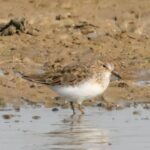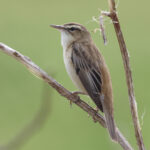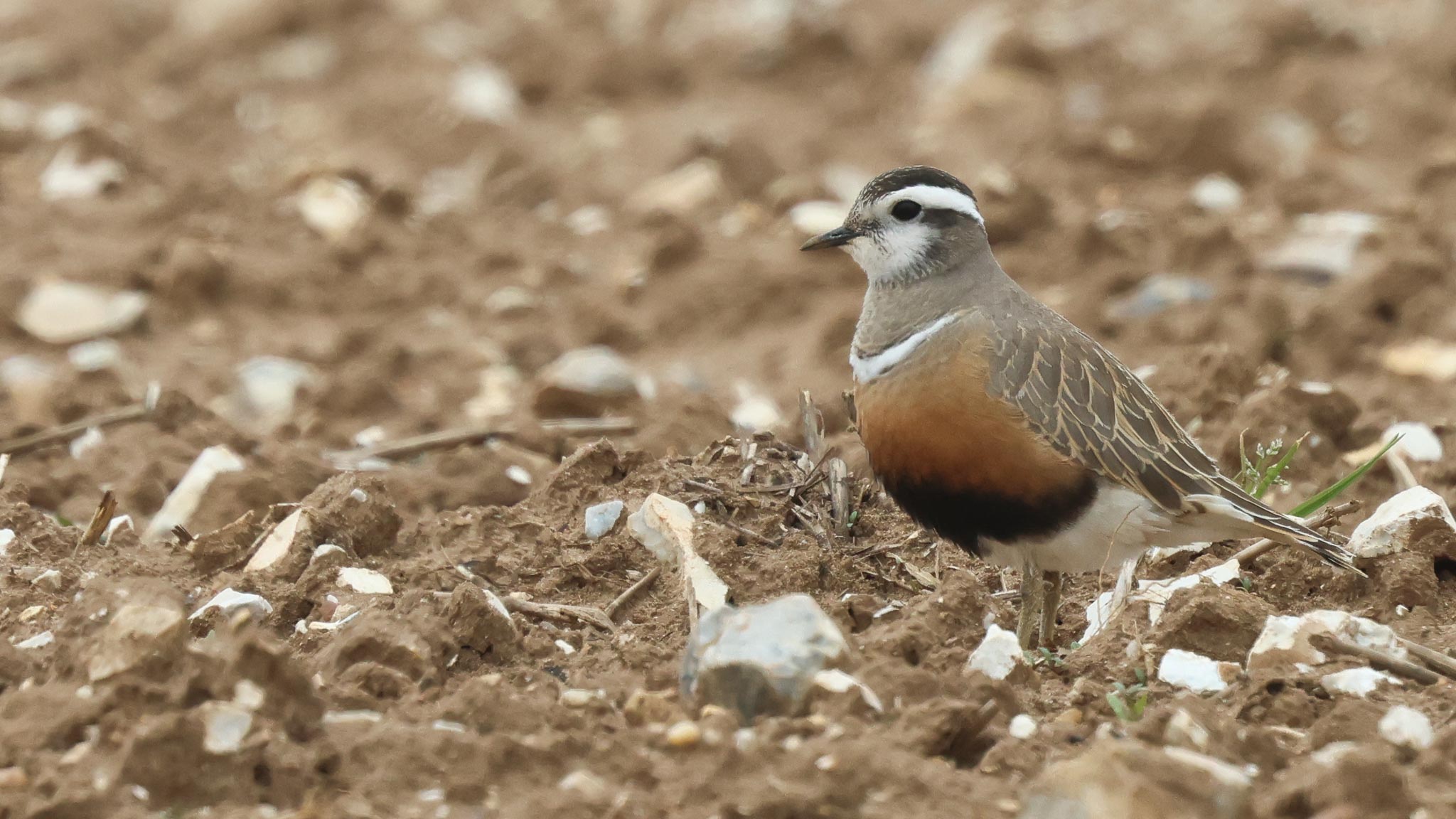Day 1 of a three day Autumn Tour & Wader Spectacular. It was a gloriously sunny day with wall-to-wall blue skies, pleasantly warm out of the blustery ENE wind.
On our way over to Holkham, two Red Kites hung in the air over the trees just west of Wells. As we drove up along Lady Anne’s Drive, we could see a small group of Egyptian Geese out on the grass, and as we got out of the minibus a couple of Marsh Harriers were enjoying the wind over the bank off to the east.
We set off west on the inland side of the pines, where we thought it would be more sheltered from the wind. A Brambling was calling its wheezy call and we had just found it perched high in a poplar near the path when we had to get out of the way for a Land Rover coming down the track. When we looked back it was gone. A fresh arrival, come here from Scandinavia for the winter.
There would be rather too many Land Rovers going back and forth along the first part of the track today, often the same vehicle five, six, or more times. Apparently they are filming a Land Rover corporate video here at the moment, racing up and down the beach in vehicles and careering over various other parts of the estate. They were certainly getting their carbon budget soaring this morning, with all the toing and froing. A Chiffchaff was singing in the bushes. And, as we walked on west, a very pale Common Buzzard came over the tops of the trees above our heads.
We hadn’t gone too much further when we encoutered our first tit flock. We could hear the Long-tailed Tits calling at first, before finding them in the trees, along with Coal, Blue and Great Tits, one or two Treecreepers, several Goldcrests and Chiffchaffs. When a small warbler flew up into the top of a young oak, we caught a flash of a bold yellowish-white supercilium and a couple of pale wing bars. A Yellow-browed Warbler!
The Long-tailed Tits were on the move and the Yellow-browed Warbler quickly dropped back out of view, deeper into the trees. We could see the flock still moving through parallel with the path and a little further on, it came back out to the trees on the side of the track. The Yellow-browed Warbler flew across and landed in the top of an oak the other side, above the track. We were standing underneath, and could see it flitting around in the leaves towards the top, directly above our heads.
As the flock moved on again, the Yellow-browed Warbler flew back across the track and disappeared into the trees once more. We continued to follow but just before we got to Salts Hole, it crossed back and disappeared deeper into some thick holm oaks on the edge of the pines, where we lost sight of them.
Yellow-browed Warblers used to be very scarce visitors here, wandering off course on their way between their breeding range east of the Urals to wintering sites in SE Asia. But over the last 30 or so years, they have become increasingly common here and are now expected from mid-September. As their breeding range has expanded westwards, birds are now routinely wintering in western Europe.
Scanning across Salts Hole, we could see several Little Grebes out on the water. A Kingfisher popped up on a post at the back, then flew across to the reeds the other side. It didn’t seem to know what it wanted to do, as it flew backwards and forwards in front of the reeds several times, before flying up into a holm oak where it landed. Then it was quickly off again and disappeared round the reeds.
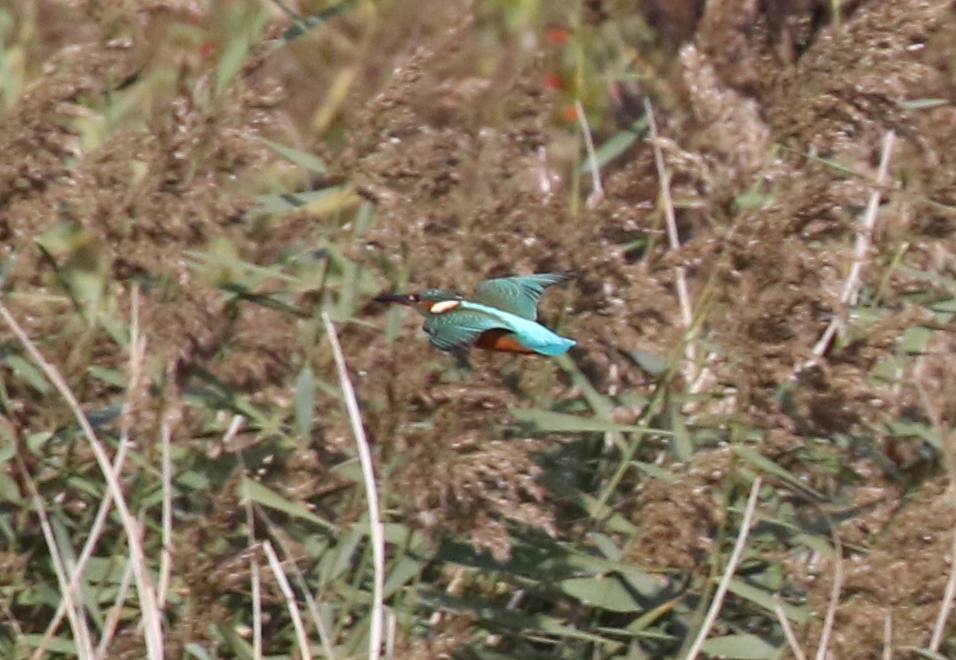
A little further on, there is a muddy pool in the reeds by the track, and as we passed by the Kingfisher flew in and landed in a tangle right next to us, just a few feet away. Unfortunately it didn’t stay long – presumably it saw us, because it quickly flew off again and we watched it disappeared away over the track ahead of us, in a flash of electric blue.
When we got to the gate just before Washington Hide, we stopped to scan across the grazing marshes. There had apparently been a Redstart on the fence here earlier but it had flown up over the bushes and there was no sign of it now. Further back, over the reeds, we picked up a distant group of Pink-footed Geese flying in, which dropped down out of view beyond.
When we got to Washington Hide, we walked up onto the boardwalk for a better view. We could now see the Pinkfeet out on the grass in the distance, and got them in the scope for a closer look. A Great White Egret flew in over the reeds, and dropped in at the back of the pool out of view. A few moments later, a second Great White Egret flew in and attempted to land on the pool too, but was quickly chased off by the first.
Several Common Darters were basking on the handrail of the boardwalk, as we set off west again. Just before Meals House, we stopped to watch several Goldcrests feeding in the holm oaks. We had a great view of them, the adults with their golden crown stripes and a juvenile still with an all grey head, at least until another fleet of Land Rovers appeared, and we had to get out of the way again.
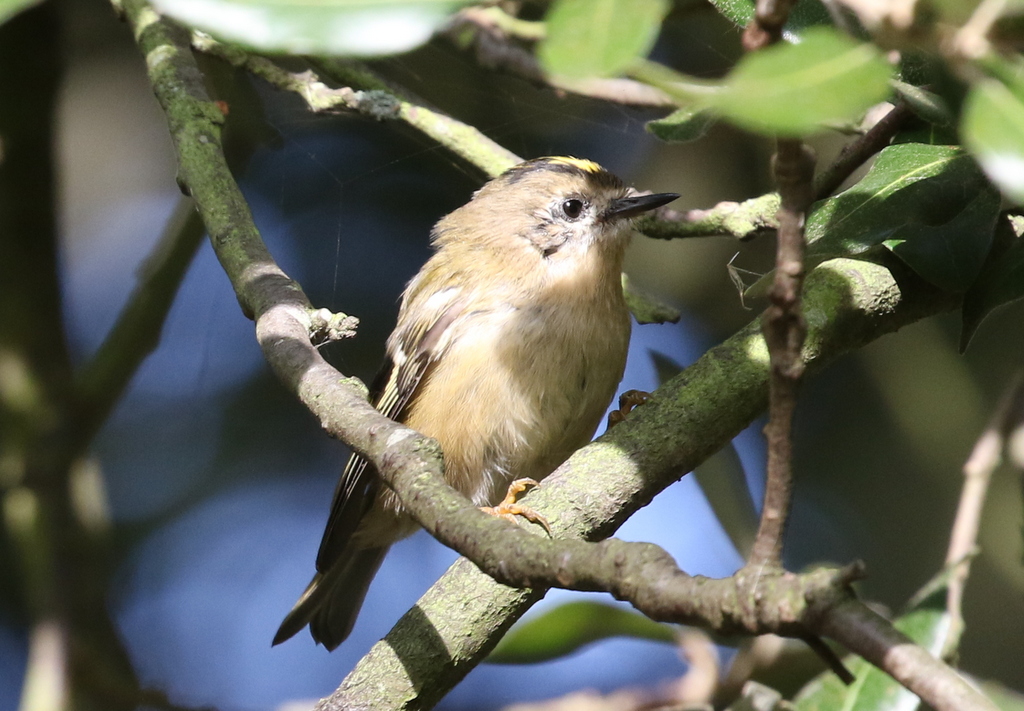
There was too much disturbance around Meals House, which is where the Land Rover crew is basing themselves, lots of vehicles and people. We had a quick look in the sycamores, but there was nothing in there today. The only good news was that once we got beyond Meals House, we would not be bothered by the Land Rovers any more.
Before the crosstracks, we came across another tit flock – we could hear Long-tailed Tits calling and see birds flitting around in the holm oaks. but the trees here were just catching the wind and the birds stayed in the thicker trees and didn’t come out to the more open ones by the path.
Just beyond the crosstracks, we heard a Pied Flycatcher calling. At first, we could just see it flicking around deep in an oak tree, but it remained frustratingly out of view. It moved into a thicker tangle behind, then across to a small hawthorn next to the oak. Suddenly it flew out, making a sally after an insect, which it caught. This time it landed right on the front of the hawthorn and we finally got a good look at it. A migrant, on its way south probably from Scandinavia, stopping off here to feed before continuing on its way to West Africa.
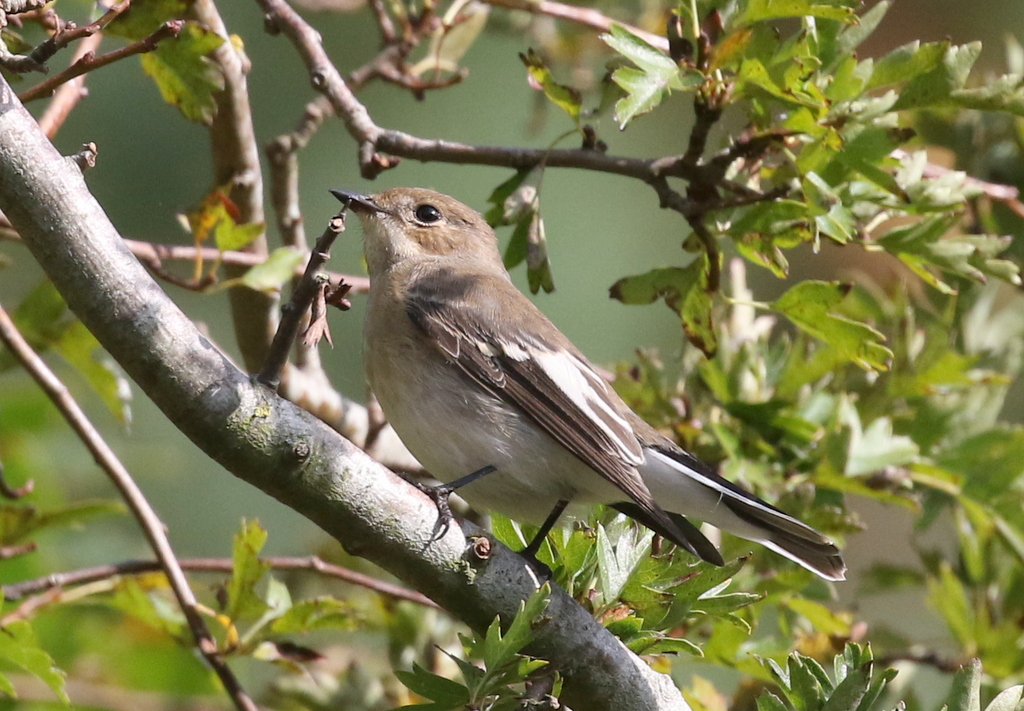
There was a good selection of butterflies, enjoying the sunshine in the more sheltered spots today. A smart Red Admiral basking on the path, a Small Copper feeding on ivy flowers, a Speckled Wood resting on a branch. There were a few dragonflies too – as well as the ever-present Common Darters, we saw a few Migrant Hawkers and one apple-green Southern Hawker hawking around the edges of the trees. A Willow Emerald damselfly was hanging on a branch over the path by a small group of sallows, a recent colonist, it is amazing how quickly it has spread.
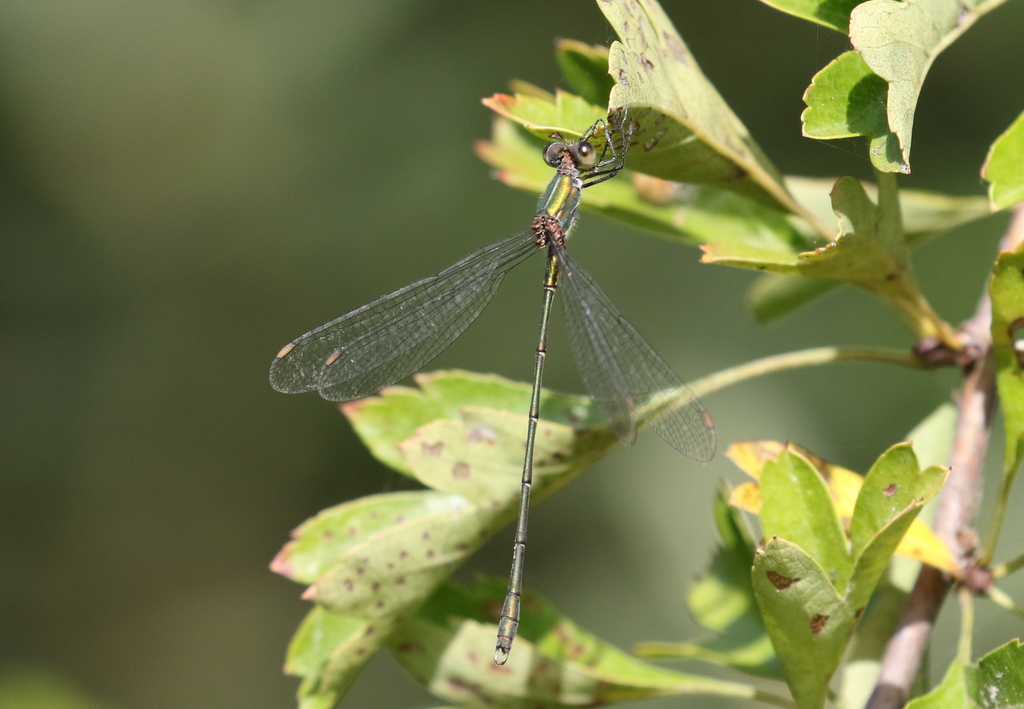
Out of the trees, we walked up into the edge of the dunes. Someone we passed told us there was a Redstart in the next valley, so we walked round to where we could get a clear view. The Redstart flicked round out of view behind some bushes, a flash of an orange-red tail. We stationed ourselves at the end of the valley and waited for it to reappear.
There were several Stonechats here, flitting from the bushes down to the ground and back up again. Eventually the Redstart reappeared and gave itself up properly. Several times it perched nicely on the top of one of the small bushes, where we could get it in the scopes. Another nice migrant on its way from Scandinavia to Africa.
Looking out across the grazing marshes, we could see the herd of cattle distantly in the top corner. From time to time, a white shape would appear in the long grass in between them, the Cattle Egrets. We counted at least four, the maximum we could see simultaneously, but there could have been more. Another Great White Egret was stalking along the edge of the reeds out on the pool on the edge of the grazing marsh, looking the other way towards Decoy Wood. Through the scopes, we could see its long dagger-like yellow bill.
A Green Woodpecker yaffled from behind the natterjack pools and we looked across to see it fly up and across past us, heading for the pines. A small group of Siskins came out of the trees and flew over, heading off west – we saw, and particularly heard, quite a few small parties today. An orange Wall butterfly posed nicely in the short grass on the dunes.
On the walk back, another Brambling flew over calling and dropped down into the bushes by the ditch beyond the reeds. Presumably the same Pied Flycatcher flitted across the path and landed briefly in the cherry trees just before the crosstracks. A Bullfinch called and perched briefly in the bushes by the path in front of Washington Hide, where three late Sand Martins were hawking over the reeds. The Kingfisher was still flying around Salts Hole as we passed.
There is nowhere to sit in The Lookout now, as all the tables have been removed, so we drove over the road and up to the car park by the Park for lunch. It was better here, out of the wind. A perfect place for a post-lunch nap on the grass in the sunshine, but we didn’t have time for dozing this afternoon.
A Brown Shrike had been found earlier this morning at Warham Greens, a short drive along the coast, so we decided to head over there to try to see it. We managed to find a parking space on Garden Drove and walked down the track towards the saltmarsh. Permission had been granted to go into the edge of the field, so we walked along the mown weedy margin to where several people were already gathered. The large open field meant we could maintain social distancing and avoid ‘mingling’ between bubbles, while all enjoying the bird.
We were quickly looking at the Brown Shrike, perched low down, in the dead umbellifers at the bottom of the hedge. It kept dropping down to the ground on the margin after insects, before flying back up to another perch. We had great views of it in the scopes. Brown above, with a more chestnut crown in the sunshine, and a distinct blackish mask.
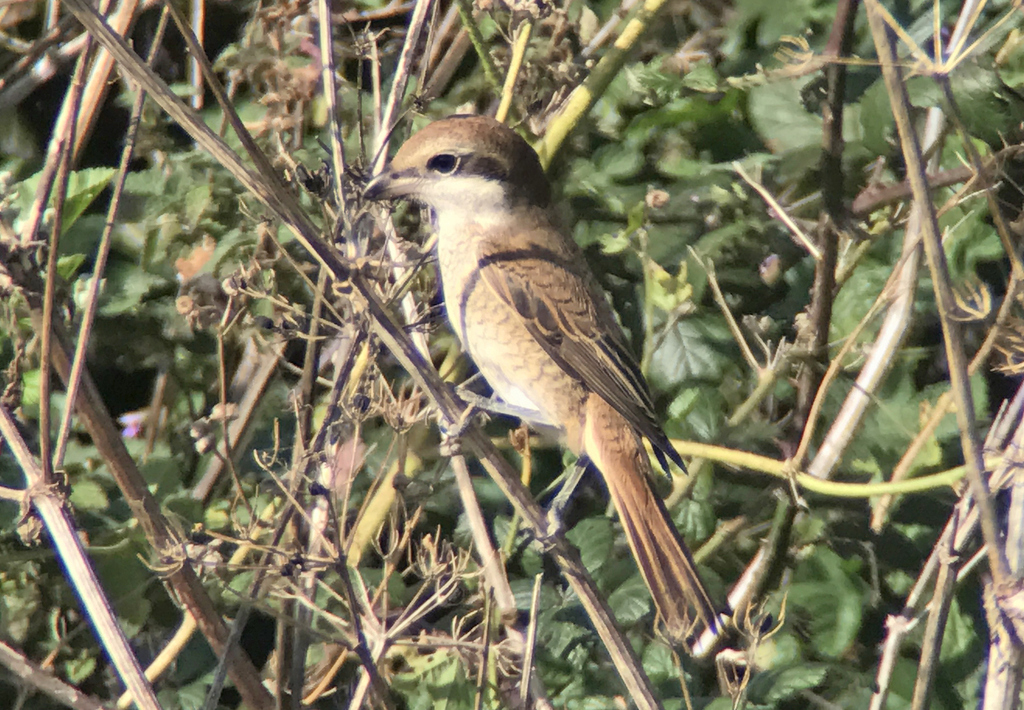
It was a young Brown Shrike, a 1st winter, with dark scallop markings on its scapulars but otherwise a rather plain brown mantle, not as strongly-marked as a similar-looking young Red-backed Shrike would be above.We could see the rather short primary projection too, another good distinguishing feature.
Brown Shrikes breed across Russia and spend the winter in India and east into SE Asia, so this young bird was a long way off course. They are rare visitors to the UK, and this was only the second one to be identified in Norfolk. An interesting bird for us to catch up with.
Another Redstart was flicking in and out of the umbellifers close to the shrike, flashing its orange red tail. A Whimbrel flew in off the saltmarsh calling, across in front of us, and disappeared off over the field inland.
Back to the minibus, we drove further east to Stiffkey. A flock of Long-tailed Tits was up in the trees in the small copse by the permissive path as we walked down beside the road, but we couldn’t see anything in with them today.
It was quiet along the riverbank, a bit windy out here today. When we got to one of the places where we could get a view over the reeds, we could see the Spoonbills gathered on the island. Some were asleep, but others were awake and preening, so we could see their distinctive bills. We counted at least 18 today, a good number considering the tide was out, although some were sitting down and there might have been a few more. Two took off and flew over past us, before turning and heading out towards the harbour.
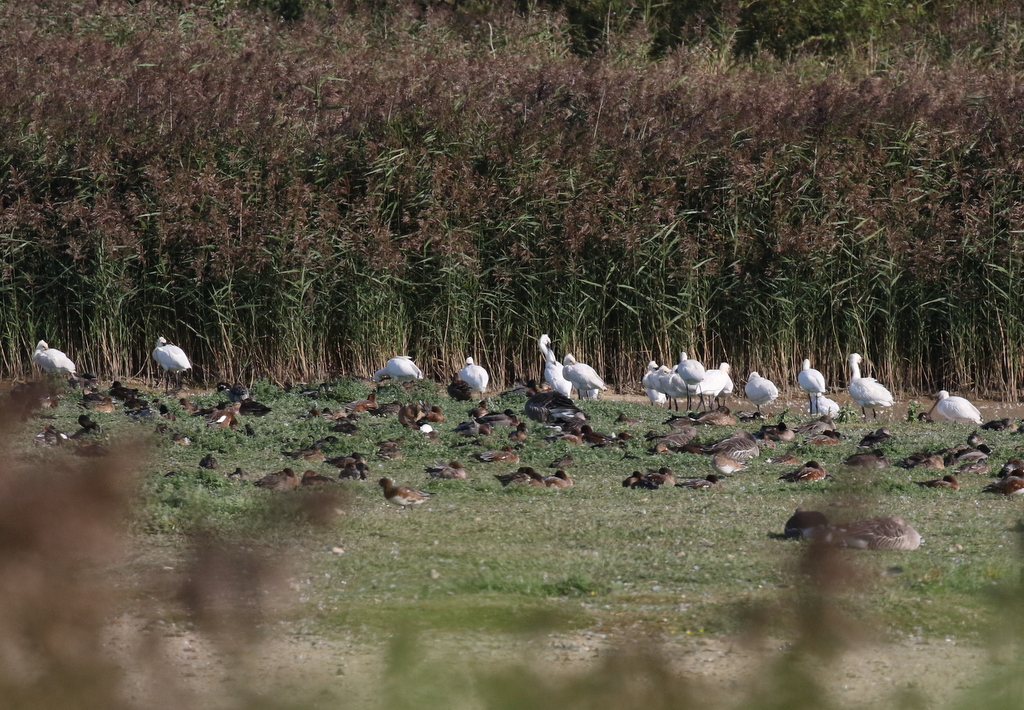
When we got up onto the seawall, we couldn’t see the Spoonbills. Where they are roosting at the moment is hidden behind the reeds from here. There were lots of Greylags, plus a few Canada Geese loafing on the grass. A liberal scattering of moulting ducks too, included Wigeon, Teal and Mallard. A Pintail was swimming out on the water – though now in dull eclipse plumage, the size and shape still sets it apart from the others.
A few Ruff and Black-tailed Godwits were scattered round among all the wildfowl. We walked further up and looked back to see a single Green Sandpiper, tucked in on the edge of the reeds, working its way along the this strip of mud beyond the water. A Common Buzzard perched up on the edge of the poplars at the back was busy eating something.
The tide was still out in the Harbour. We could see all the seals hauled out on the sandbars beyond Blakeney Point, in the distance. A Greenshank flew past down the creek, and landed on the shore of the channel a bit further up, by the boats. Another three Spoonbills flew out past us, heading from the Fen out into the Harbour to feed in the muddy creeks.
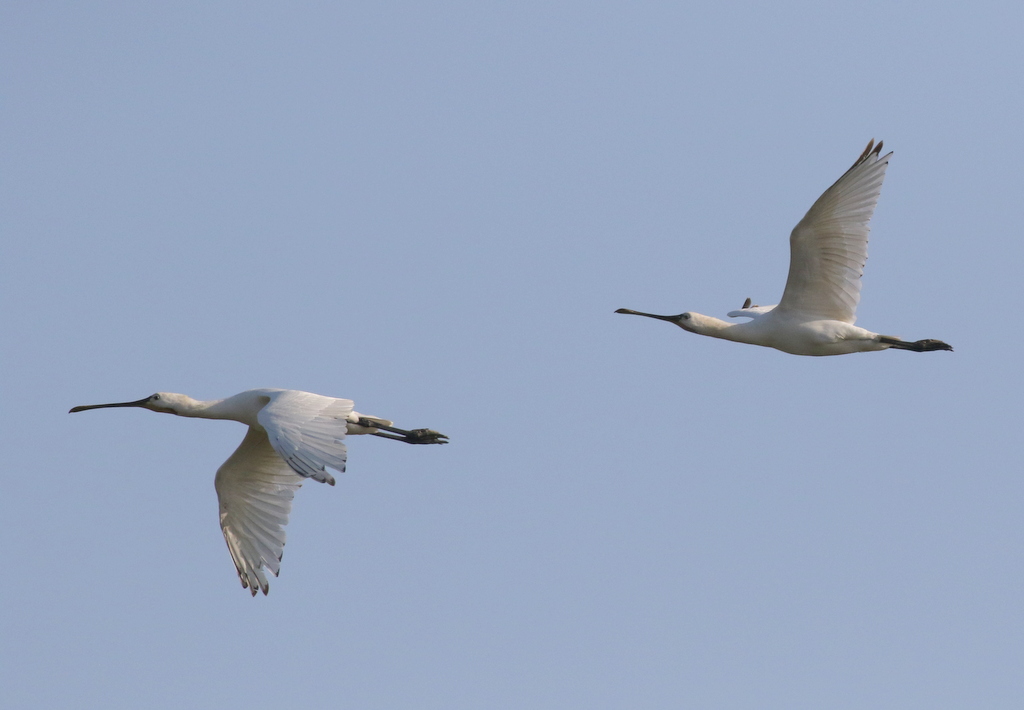
Looking out into the pit, we could see a couple of Brent Geese. They are just starting to return here for the winter now, back from their breeding grounds in Siberia. There was a good selection of waders too, if a little distant – Knot, Grey Plover, Oystercatchers, Curlew, a single Bar-tailed Godwit. There were lots of gulls loafing on the mud too.
We continued round and down to the edge of the harbour, where we stood admiring the view in the later afternoon sunshine. The Greenshank was now feeding on the edge of the channel opposite, giving us lovely views.
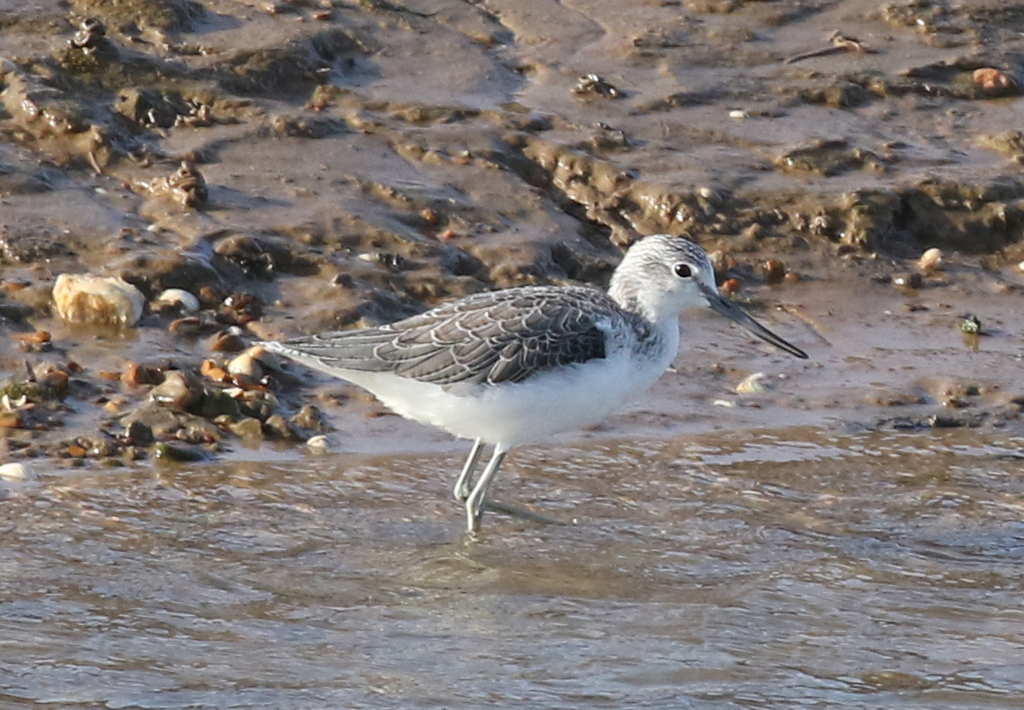
It is a magical spot here, and we could have sat for hours, but it was time to head back. It had been an exciting first day – two more days to look forward to.



